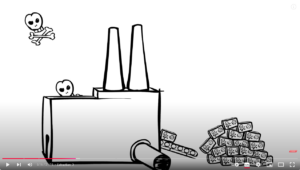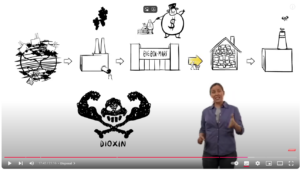Hello! Welcome back to my blog.
This week has been very interesting, a little intense too because we are starting to uncover a lot of the root reasons behind the current environmental state of the planet and it is sad and at times discouraging.
However, it made me very happy to dig out the book ‘Cradle to Cradle’ which I had already read a couple of years ago. Re-reading certain chapters having now started a design-related degree gave me a whole new understanding of it. Interior design is a very ‘material’ field and feels like a never ending source of consumption as it is still so heavily dependent on aesthetic. I recently read an article about a study made by LMN Architects that found that, even though it has always been thought that the interior of a building ‘would account for only 7 to 10 per cent of its overall carbon footprint’, ‘throughout an average building’s life span, the carbon footprint of its interiors will equal if not exceed that of the structure’s construction.’ Finding this out was quite shocking to me but I can definitely see how that is the case. Going back to ‘Cradle to Cradle’, it was very nice to hear examples of design practices that can make a difference, I thought the way it is written is not aggressive at all and actually quite encouraging, unlike a lot of publications that deal with similar topics. I really resonate with what they were saying about biological mass and technical mass and how keeping them separated is essential to a circular production cycle. In interior design, for example, avoiding to ‘contaminate’ timber with toxic substance such as chemical varnishes would allow for the timber to be completely biodegradable and ‘return’ to the earth.
Figure 1: Screenshots from ‘The Story of Stuff’ video showing that contaminated products emit toxic substances when discarded. The toxic substances put in a product


They also talked about the benefits of creating ‘product services’, designing products to be disassembled which has so many benefits for the manufacturer, the consumer AND the planet as it creates incentive to design without hazardous materials, saves manufacturers billions of dollars in valuable materials and diminish the extraction of raw materials. This is particularly true in interior design, making all elements of construction and decoration able to disassemble would allow consumers to follow trends guilt free as they know that what they are getting rid of will stay in the production cycle (taken back by manufacturers) and the new elements they get come from the same production cycle. In the book, they use the example of carpets and that designing them to be disassembled would mean that ‘when a customer wants to replace the carpeting, the manufacturers simply removes the top, snaps down a fresh one in the desired colour, and takes the old one as food for further carpeting.’
I look forward to talking more about this with my classmates during the debate next week ads we all agreed that we really enjoyed that reading in the seminar this week.
Bibliography:
Braungart, M. and McDonough, W. (2009). <i>Cradle to Cradle: Remaking the Way We Make Things</i>. Vintage Digital.
Chouinard, H. (2020). <i>A new study shows that interior designers have a major impact on climate change</i>. [online] businessofhome.com. Available at: https://businessofhome.com/articles/a-new-study-shows-that-interior-designers-have-a-major-impact-on-climate-change.
The Story of Stuff Project (2009). <i>The Story of Stuff</i>. <i>YouTube</i>. Available at: https://www.youtube.com/watch?v=9GorqroigqM.





Leave a Reply